导学案-生本课堂
图片预览


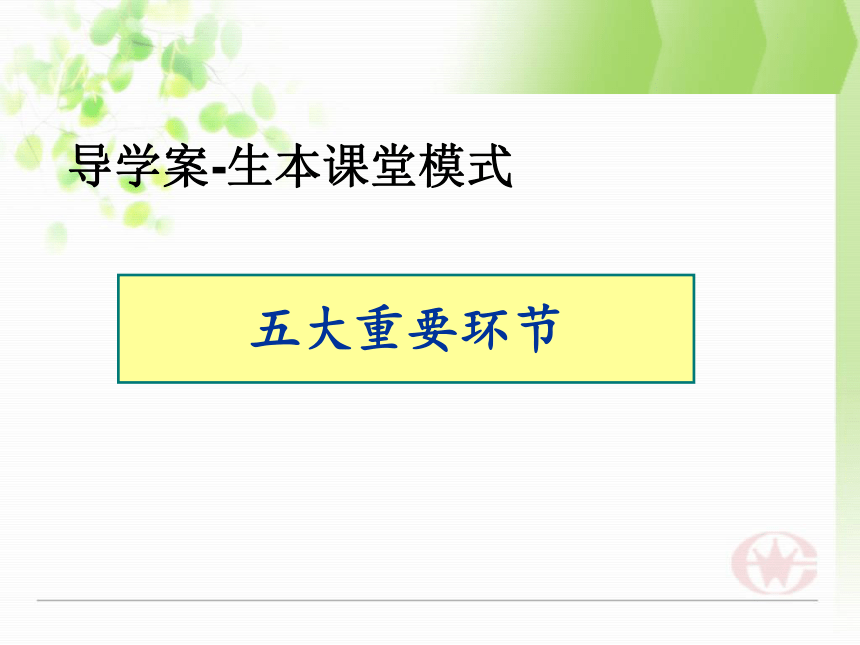
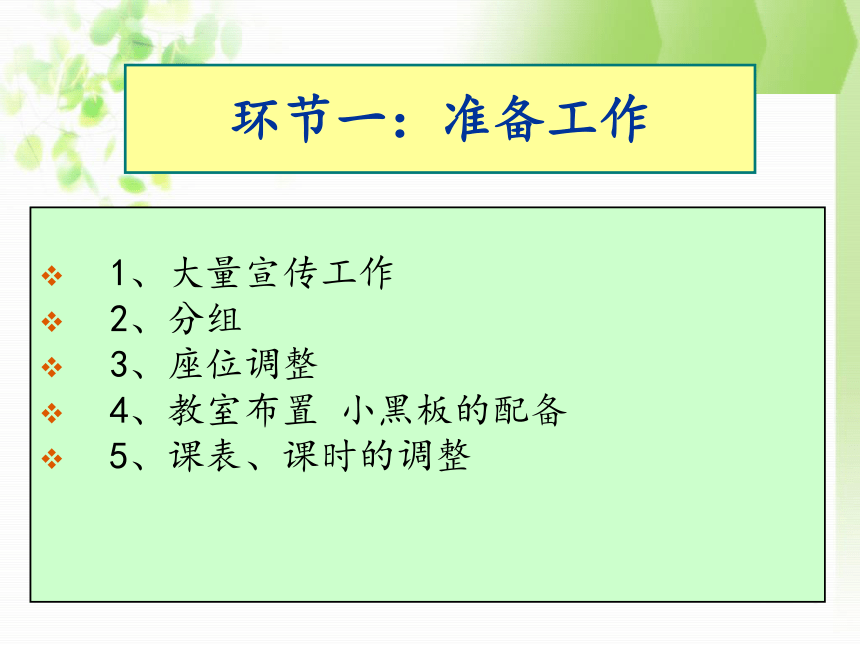
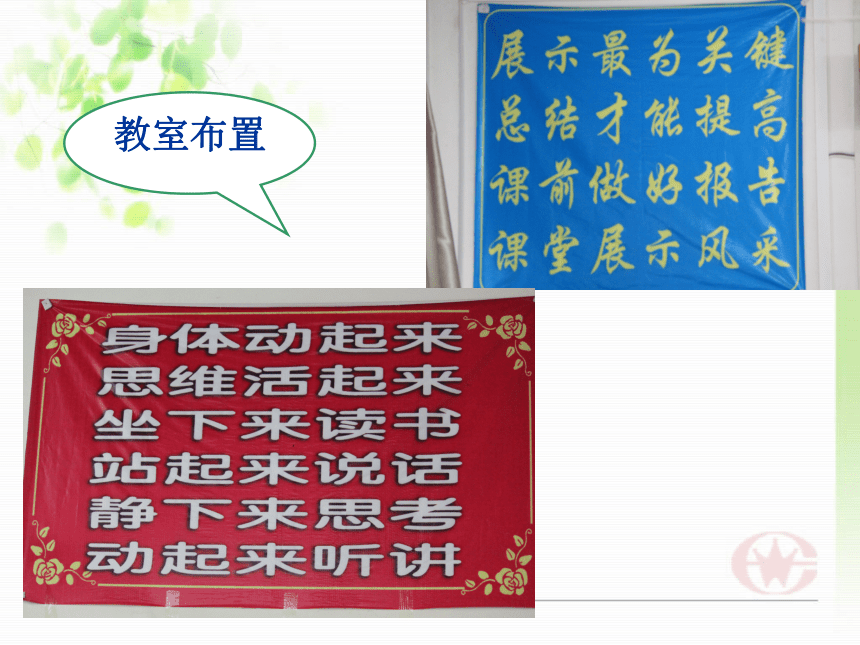
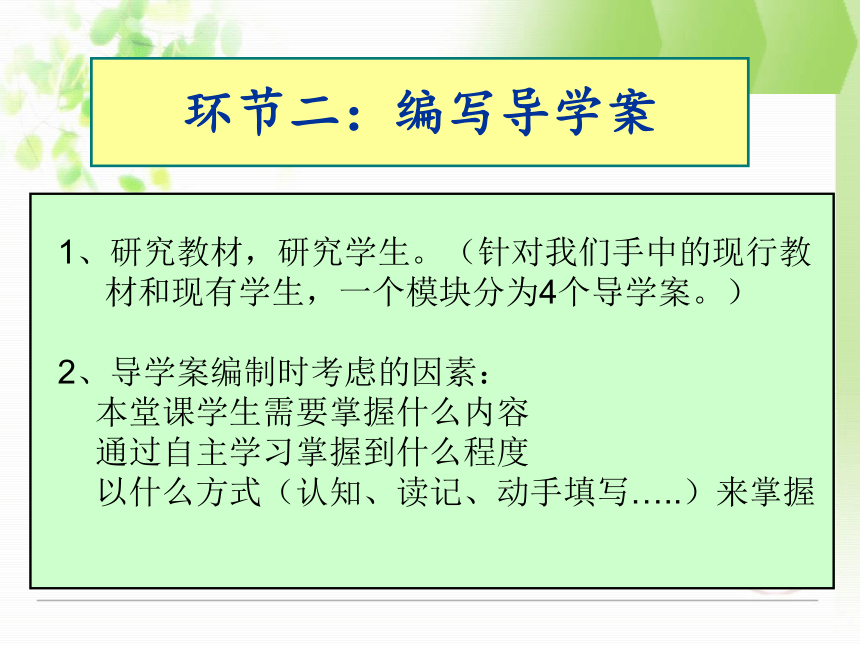
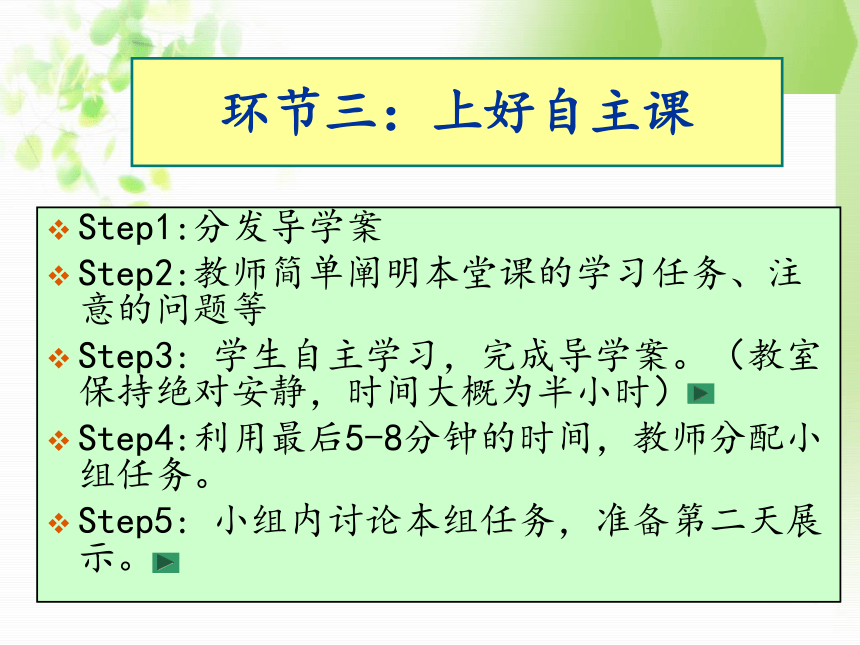
文档简介
(共16张PPT)
导学案-生本课堂模式
一个目的:以学生为本,一切为了学生的终身
发展。
二主课堂:自主课和展示课。
三条原则:1、不延长学生的学习时间
2、不加重学生的学习负担
3、不牺牲任何应开课程
四项工作:学生——学、做、展、悟
教师——编、验、点、导
学校政策行为
五大重要环节
导学案-生本课堂模式
环节一:准备工作
1、大量宣传工作
2、分组
3、座位调整
4、教室布置 小黑板的配备
5、课表、课时的调整
教室布置
1、研究教材,研究学生。(针对我们手中的现行教
材和现有学生,一个模块分为4个导学案。)
2、导学案编制时考虑的因素:
本堂课学生需要掌握什么内容
通过自主学习掌握到什么程度
以什么方式(认知、读记、动手填写…..)来掌握
环节二:编写导学案
环节三:上好自主课
Step1:分发导学案
Step2:教师简单阐明本堂课的学习任务、注意的问题等
Step3: 学生自主学习,完成导学案。(教室保持绝对安静,时间大概为半小时)
Step4:利用最后5-8分钟的时间,教师分配小组任务。
Step5: 小组内讨论本组任务,准备第二天展示。
环节四:上好展示课
1. 课前各小组将需要展示的内容板书在黑板上。
2. 各小组选派同学代表本组进行展示:讲解;释疑;操练。
3. 老师进行适时的点评,补充,鼓励。
环节五:写好学习报告
学生每周写一次学习报告进行总结和反思
复习本周内容以便进行更好的内化和吸收
阶段性的思考和改进
存在的问题
1. 导学案的内容偏多,偏难。
2. 学生热情渐弱。
3. 深层次的语言能力有待提高。
4. 小组如何才能良性发展。
改进措施
1. 精简学案,把握学案的难度。
2. 自主课确保学生讨论时间,任务分配力求科学合理。
3. 要求学生尽量用英语脱稿讲解,让其他同学多说多练。
4. 实行小组竞争机制,加强小组合作,促进小组良性发展。
Module 1 Europe (语法学案)
Passive voice 被动语态 (参看《聚焦课堂》听课手册p5,完成下列任务)
一 构成
1 读下面的句子,勾划出谓语动词。
1)Pairs is visited by more than eight million tourists every year.
2) The Parthenon was built during this period.
3) More than 2000 trees will be\are going to be planted on the mountain.
4) -----Why do you come to school on foot today
____My bike is being repaired.
5) A lot of work has been done about the project.
6) The tickets had been sold out when we got to the station.
2 归纳总结出不同时态的被动语态形成。
一般现在时:_________________________________________
一般过去时:_________________________________________
一般将来时:_________________________________________
现在进行时:_________________________________________
现在完成时:_________________________________________
过去完成时:_________________________________________
二 用法
1. 当不知道或没必要指明_____________时,或着重强调_____________时,可以用被动语态,要求我们在写作或者表达时恰当运用。
2. 编造4个句子,恰当的使用被动语态。
1) __________________________________________________________________
2) __________________________________________________________________
3) __________________________________________________________________
4) __________________________________________________________________
三. 注意问题(考点)
1.不及物动词与不及物动词短语,如take place, happen, come, come out, come true, belong to等无被动语态。翻译下列句子。
1)昨天发生了一场车祸。
2) 我相信我的梦想会实现。
3) 这个大房子属于他的叔叔。
2.主动表被动
1)值得做_________ __ 2) 需要做___________ _
3)主语+adj.(easy\hard\difficult…)+______
翻译;
这部电影值得一看。_________________________________________________.
这种花需要每天浇水。_________________________________________________.
如果我们多读多记,英语学起来很容易。
_____________________________________________________________________.
*3 feel \hear\ listen to\make\have\let\see\notice\observe\watch+ sb+do
sb be felt \heard \made \had…..+_____________.
eg. The naughty boy often makes his sister cry.
被动句:__________________________________________
Module 5-6 Grammar 学案
一.定语从句及其相关概念。
定语从句:在定语从句中起定语的作用,修饰一个名词或代词,有时可以修饰一个句子。
定语从句的构成:先行词+关系词(关系代词或关系副词)+从句
先行词:被定语从句修饰的词。
eg: This is the school where we study.
关系代词:关系代词放先行词之后连接定语从句,在从句中充当主语,宾语,表语或定语,关系代词有:who(指代人,主语),whom(宾语),which(物)that(人或物), whose(定语)
eg: This is the place which we visited.
关系副词:关系副词在从句中充当表示时间,地点,原因的状语,关系副词有:when, where, why.
eg: The reason why he was late was that he missed the bus.
This is the place where he was brought up.
二. 如何选择定语从句的引导词,即关系代词或关系副词。
先找出先行词。
分析先行词在从句中充当的成分
例句分析:
1).This is our headmaster who/that has something important to tell you. (主语)
2).I want to take away the books which/that you lent to me. (宾语,也可省略关系词)
3).The school shop, whose customers are mainly students, is closed for holidays.(定语)
4).The days are gone when we suffered a lot.(时间状语)
5).Do you know any shop nearby where I can buy flowers (地点状语)
6).The reason why she was sad was that she lost her favorite pet.(原因状语)
7).That’s the reason that he explained to us just now. (宾语)
三. that 和 which 的区别。
宜用that而不宜用which的情况。
① 当先行词是不定代词 everything,anything, something, nothing, none, the one, all, much, little, all, few时。
eg: Is there anything that I can do for you
The book contains much that is useful.
② 当先行词被the only, the very, few, little, no, all等修饰时。
eg: This is the very person that I want to meet.
③ 当先行词前有序数词或形容词的最高级(the last包含在内)修饰时
eg: I will never forget the first lesson that Mr. Black taught me.
This is the greatest party that I have ever taken.
④ 当先行词中既有人又有物时。
eg: He talked happily about the students and the books that interested him in the school.
宜用which 而不用that的情况。
① 介词+ which,不能用that.
eg: This is the house in which he once lived.
This is the teacher form whom I learn a lot.
② 在非限制性定从句中,作主语,宾语,表语。
The woman, who is standing there is my sister.
一些收获
学生方面
学习兴趣提高,知识掌握更牢固,一些受益终身的能力得到培养
老师方面
加强学习,提高自身素质,做一名幸福的人民教师。
结束语
愿这种模式能许给孩子们一个更加美好的明天!
Thank you!
导学案-生本课堂模式
一个目的:以学生为本,一切为了学生的终身
发展。
二主课堂:自主课和展示课。
三条原则:1、不延长学生的学习时间
2、不加重学生的学习负担
3、不牺牲任何应开课程
四项工作:学生——学、做、展、悟
教师——编、验、点、导
学校政策行为
五大重要环节
导学案-生本课堂模式
环节一:准备工作
1、大量宣传工作
2、分组
3、座位调整
4、教室布置 小黑板的配备
5、课表、课时的调整
教室布置
1、研究教材,研究学生。(针对我们手中的现行教
材和现有学生,一个模块分为4个导学案。)
2、导学案编制时考虑的因素:
本堂课学生需要掌握什么内容
通过自主学习掌握到什么程度
以什么方式(认知、读记、动手填写…..)来掌握
环节二:编写导学案
环节三:上好自主课
Step1:分发导学案
Step2:教师简单阐明本堂课的学习任务、注意的问题等
Step3: 学生自主学习,完成导学案。(教室保持绝对安静,时间大概为半小时)
Step4:利用最后5-8分钟的时间,教师分配小组任务。
Step5: 小组内讨论本组任务,准备第二天展示。
环节四:上好展示课
1. 课前各小组将需要展示的内容板书在黑板上。
2. 各小组选派同学代表本组进行展示:讲解;释疑;操练。
3. 老师进行适时的点评,补充,鼓励。
环节五:写好学习报告
学生每周写一次学习报告进行总结和反思
复习本周内容以便进行更好的内化和吸收
阶段性的思考和改进
存在的问题
1. 导学案的内容偏多,偏难。
2. 学生热情渐弱。
3. 深层次的语言能力有待提高。
4. 小组如何才能良性发展。
改进措施
1. 精简学案,把握学案的难度。
2. 自主课确保学生讨论时间,任务分配力求科学合理。
3. 要求学生尽量用英语脱稿讲解,让其他同学多说多练。
4. 实行小组竞争机制,加强小组合作,促进小组良性发展。
Module 1 Europe (语法学案)
Passive voice 被动语态 (参看《聚焦课堂》听课手册p5,完成下列任务)
一 构成
1 读下面的句子,勾划出谓语动词。
1)Pairs is visited by more than eight million tourists every year.
2) The Parthenon was built during this period.
3) More than 2000 trees will be\are going to be planted on the mountain.
4) -----Why do you come to school on foot today
____My bike is being repaired.
5) A lot of work has been done about the project.
6) The tickets had been sold out when we got to the station.
2 归纳总结出不同时态的被动语态形成。
一般现在时:_________________________________________
一般过去时:_________________________________________
一般将来时:_________________________________________
现在进行时:_________________________________________
现在完成时:_________________________________________
过去完成时:_________________________________________
二 用法
1. 当不知道或没必要指明_____________时,或着重强调_____________时,可以用被动语态,要求我们在写作或者表达时恰当运用。
2. 编造4个句子,恰当的使用被动语态。
1) __________________________________________________________________
2) __________________________________________________________________
3) __________________________________________________________________
4) __________________________________________________________________
三. 注意问题(考点)
1.不及物动词与不及物动词短语,如take place, happen, come, come out, come true, belong to等无被动语态。翻译下列句子。
1)昨天发生了一场车祸。
2) 我相信我的梦想会实现。
3) 这个大房子属于他的叔叔。
2.主动表被动
1)值得做_________ __ 2) 需要做___________ _
3)主语+adj.(easy\hard\difficult…)+______
翻译;
这部电影值得一看。_________________________________________________.
这种花需要每天浇水。_________________________________________________.
如果我们多读多记,英语学起来很容易。
_____________________________________________________________________.
*3 feel \hear\ listen to\make\have\let\see\notice\observe\watch+ sb+do
sb be felt \heard \made \had…..+_____________.
eg. The naughty boy often makes his sister cry.
被动句:__________________________________________
Module 5-6 Grammar 学案
一.定语从句及其相关概念。
定语从句:在定语从句中起定语的作用,修饰一个名词或代词,有时可以修饰一个句子。
定语从句的构成:先行词+关系词(关系代词或关系副词)+从句
先行词:被定语从句修饰的词。
eg: This is the school where we study.
关系代词:关系代词放先行词之后连接定语从句,在从句中充当主语,宾语,表语或定语,关系代词有:who(指代人,主语),whom(宾语),which(物)that(人或物), whose(定语)
eg: This is the place which we visited.
关系副词:关系副词在从句中充当表示时间,地点,原因的状语,关系副词有:when, where, why.
eg: The reason why he was late was that he missed the bus.
This is the place where he was brought up.
二. 如何选择定语从句的引导词,即关系代词或关系副词。
先找出先行词。
分析先行词在从句中充当的成分
例句分析:
1).This is our headmaster who/that has something important to tell you. (主语)
2).I want to take away the books which/that you lent to me. (宾语,也可省略关系词)
3).The school shop, whose customers are mainly students, is closed for holidays.(定语)
4).The days are gone when we suffered a lot.(时间状语)
5).Do you know any shop nearby where I can buy flowers (地点状语)
6).The reason why she was sad was that she lost her favorite pet.(原因状语)
7).That’s the reason that he explained to us just now. (宾语)
三. that 和 which 的区别。
宜用that而不宜用which的情况。
① 当先行词是不定代词 everything,anything, something, nothing, none, the one, all, much, little, all, few时。
eg: Is there anything that I can do for you
The book contains much that is useful.
② 当先行词被the only, the very, few, little, no, all等修饰时。
eg: This is the very person that I want to meet.
③ 当先行词前有序数词或形容词的最高级(the last包含在内)修饰时
eg: I will never forget the first lesson that Mr. Black taught me.
This is the greatest party that I have ever taken.
④ 当先行词中既有人又有物时。
eg: He talked happily about the students and the books that interested him in the school.
宜用which 而不用that的情况。
① 介词+ which,不能用that.
eg: This is the house in which he once lived.
This is the teacher form whom I learn a lot.
② 在非限制性定从句中,作主语,宾语,表语。
The woman, who is standing there is my sister.
一些收获
学生方面
学习兴趣提高,知识掌握更牢固,一些受益终身的能力得到培养
老师方面
加强学习,提高自身素质,做一名幸福的人民教师。
结束语
愿这种模式能许给孩子们一个更加美好的明天!
Thank you!
同课章节目录
